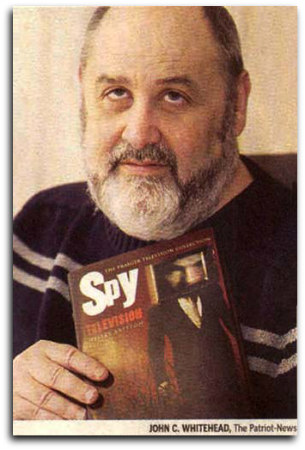
HOMEWesley Britton’s Books,
|
Spies on FilmSpies on Television & RadioSpies in History & LiteratureThe James Bond Files |
|
Wesley Britton’s Books, Interviews, and Media Appearances ~ “Classic spy genre television
revisited”
By Mary O. Bradley 
For a half-century, television audiences have shared vicariously in the globe-trotting adventures of fictional secret agents. But the cloak-and-dagger stuff contributed more than just escapist entertainment, according to the author of a new book analyzing 50 years of spy television programs. The classic espionage shows are remembered for the breakthrough roles they offered to minorities and women, said Wesley A. Britton, author of Spy Television, the first book-length overview of secret agent programs. From I Led Three Lives to 24, the programs also are period pieces reflecting the politics of the era as the enemy morphed through the decades from communists to government conspiracies to domestic terrorism. “In the 1950s, it was all black and white programming and a good deal of it was overtly propagandistic,” Britton said in an interview. “One of Hollywood’s ways to deal with McCarthyism and the resulting blacklist was putting on programs that showed how valiant we were in the fight against the communists.” An example, he said, was I Led Three Lives (1953-56) where actor Richard Carlson portrayed real life Herbert A. Philbrick, an average citizen who infiltrated the Communist Party to work undercover for the FBI. The producers “made a great deal of effort to connect themselves with specific law enforcement agencies, and they had ex-agents as script consultants,” said Britton, 50, an adjunct professor of English at Harrisburg Area Community College. The flag-waving, however, was not without its critics. Britton said that CBS’ 1952-53 series Biff Baker, U.S.A. starred Alan Hale Jr. as an American importer/exporter who was drawn into international intrigue while on overseas buying trips. Business organizations complained that foreign countries were going to believe that all business people were spying for the United States. The production company responded that the scripts were reviewed by the U.S. Treasury Department and the FBI and that the shows were meant to be statements about democracy so any attacks against the show were statements against democracy, Britton said. In the 1960s, the secret agent boom exploded with the release of the 1962 motion picture Dr. No that brought Ian Fleming’s James Bond 007 to life. Television responded. “The Man from U.N.C.L.E. was without any question an attempt to take James Bond off the silver screen and bring him into the living room,” said Britton, a Lower Paxton Twp. resident. However, “in the 1960s, a lot of TV producers went to great lengths to try to disassociate their productions from the Cold War. The enemies were egomaniacal madmen who wanted to conquer the world,” he said. Thus, the nemesis of the agents in The Man from U.N.C.L.E. was a secret international crime syndicate named THRUSH. “In the 1970s, we had all these comic book characters, such as Steve Austin [The Six Million Dollar Man] and Wonder Woman – complete escapist stuff,” Britton said. “The 1980s was the nadir of TV spies. We had questions about whether or not spies could even be heroes. Hollywood wasn’t sure about that, so we ended up getting characters, such as ‘The Equalizer’ who spent a lot of time questioning what he had done in the past,” Britton added. “We started to see more family involvement and personal relationships. The age of the old roguish swashbuckler was kind of gone. “In the 1990s, a lot of secret agent shows became absorbed in modern science fiction – The X-Files, La Femme Nikita, and The Invisible Man. By this point, our national cynicism had kicked in,” Britton said. “We didn’t have the romanticism of the 1960s. Who is the enemy? Us or them? We were worried about our supervisors. We were worried about our own institutions.” Of the new spy shows, Britton gives an A to ABC’s Threat Matrix, currently on hiatus, and A&E’s MI-5, shown in Britain as Spooks. “They are very realistic,” he said. Each deals with homeland security threats and has an ensemble cast. “They are a modern reworking of Mission: Impossible. I think those ensemble efforts are going to be continuing in one guise or another. Some are going to be more successful than others, but that Mission: Impossible concept will be there forever because we like to have teams of agents,” he said. Britton said espionage dramas broke ground for minorities. I Spy teamed Bill Cosby (the first black performer to have a starring role in a regular television series) and Robert Culp as agents working undercover on the professional tennis circuit. Another black actor, Greg Morris, was cast as Barney Collier in Mission: Impossible. Most actresses of the era found themselves cast as “either housewives or secretaries or decorative admirers of male superiority, but in espionage dramas they could be partners,” Britton said. Emma Peel (Diana Rigg) in The Avengers “did more action than Steed [Patrick Macnee]. She was smarter than Steed.” Even in the spy spoof series, Get Smart, Agent 99 (Barbara Feldon) “was clearly smarter than her partner,” Maxwell Smart (Don Adams). Britton said these breakthroughs were possible because espionage shows, like science-fiction series such as Star Trek, took characters out of everyday situations into the realm of a make-believe world where equality and brotherhood prevailed. The Man from U.N.C.L.E. remains Britton’s favorite show “because at the time it was my favorite as a kid,” he said. He views The Avengers as “the best series ever made” because of its stylistic elements. In addition to studying and writing about the spy genre, Britton collects memorabilia and spin-off merchandise, such as lunch boxes, books, magazines, board games, videos and sound-track recordings. He has a doctorate in English from the University of North Texas. Britton, who has lost his vision due to retinitis pigmentosa, a degenerative eye condition, does research and writing using a computer and technological aids, such as talking book devices. He remains a fan of the spy genre and listens to television programs and movies. “I can remember the joys of looking at Diana Rigg as Mrs. Emma Peel back in the 1960s, but I haven’t a clue about the joys of looking at Jennifer Garner,” the star of Alias, he quipped. From the Harrisburg Patriot-News,
Sunday, March 21, 2004.
|